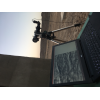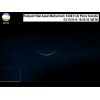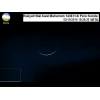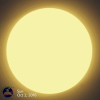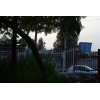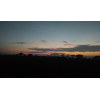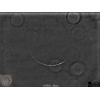Visibility of Muharram Crescent 1438 AH
- When to Observe Muharram Waxing (NEW) Crescent ?
- Muharram Waxing (NEW) Crescent Observation Results
- The OFFICIAL First Day in Different Countries
- When to Observe Dhul Hijjah Waning (OLD) Crescent ?
- Dhul Hijjah Waning (OLD) Crescent Observation Results
When to Observe Muharram Waxing (NEW) Crescent ?
The geocentric conjunction (Geocentric New Moon) will occur Inshalla on (Saturday 01 October 2016) at 00:12 UT.
Sighting the new crescent on (Saturday 01 October 2016) and (Sunday 2 October 2016) is shown in the below graphs using the program Accurate Times by Mohammad Odeh according to Odeh criterion. Where:-
- It is impossible to see the crescent from the areas located under the red color. Because either the Moon on this day sets before the Sunset and/or the topocentric conjunction occurs after the Sunset.
- The crescent is expected to be seen by optical aid only from the areas located under the blue color.
- The crescent is expected to be seen by optical aid from the areas located under the magenta color. In these areas the crescent could be seen by naked eye if the atmospheric conditions are superb and the observer is experienced.
- The crescent is expected to be easily visible by naked eye from the areas located under the green color.
- The crescent cannot be seen from uncolored areas, even though the Moon sets in these locations after the Sunset and the topocentric conjunction occurs before the Sunset, but the Moon is not sufficiently illuminated in order to be seen as crescent even by optical aid.
- Kindly notice that the below graph shows the possibility of seeing the crescent from areas between 60 degrees north of Equator down to 60 degrees south of Equator.


According to the Universal Hejric Calendar (UHC), which is based on the calculated crescent visibility, the start of this month in the Eastern Region will be on Sunday 02 October 2016 and in the Western Region will be on Sunday 02 October 2016. Kindly notice that the UHC is a pre-calculated calendar, which adopts a certain criterion to start the new Hejric month. Your country/organization might adopt different criterion to start the new Hejric month. So it is highly advised to read the UHC website before giving any judgment.
- Results of seeing the crescent, and the first day of the month in different countries will be added here Inshalla as we receive the reports from ICOP's members. If you wish to be a member in ICOP, or to know more about it, kindly click here.
Muharram Waxing (NEW) Crescent Observation Results
Sat 01 October 2016
Algeria
Australia
Indonesia
Mr. AR Sugeng Riyadi said: "I tried to observe the new crescent of Muharram 1438 AH on Saturday, Oct 1st, 2016 with my team of Rowasiya Observatory and SAC (Solo Astro Club) at Al-Buruj Observatory in Kudus Central Java Indonesia. The west horizon was cloudy and the crescent moon was not seen even by Computerised Telescope. According to the calculation and Imkan Rukyat MABIMS criterion, the 1st of Muharram 1438 AH in Indonesia will begin on Sunday,.02 Oct 2016."
Libya
Morocco
Dr. Hassan Talibi said: "الوثيقة المرافقة تيبن أن التوقعات الحسابية لوزارة الأوقاف تشير إلى أن فاتح محرم سيكون يوم الإثنين، أما الإعلان الرسمي فلم يتم بثه لحد كتابة هذه الأسطر ."
Nigeria
Mr. Qamarudeen Muhammad said: "It was cloudy here at Ilorin. I can equally report based on a trusted information from one of my acquaintance, that part of Lagos i.e Agege/Ikeja was equally cloudy at time of and after sunset."
Mr. Yunusa Yakubu said: "I went to our usual Sighting location at 17:33 inside the old airport near the old control tower, I was joined later by a friend Dr Ahmad Sabo. The Sun has sets @ 17:45 behind cloud which makes the sighting possibility negetive."
Oman
Prof. Mohammed Al-Bussaidi said: "The weather condition was cloudy and the Crescent Moon was not sighted."
Saudi Arabia
Mr. Turki Alamri said: "with AOD 0.23 for 519 nm i started two hours before sunset trying to do more techniques , unfortunately i could not capture the new crescent even after sunset the west horizon was a pit hazy with some clouds ."
Sri Lanka
Mr. Abdul Rahman Razeen said: "Aalaikum. Today 1-10-2016AD=29-12-1437AH is the sighting day for the month of Muharram 1438AH.. I was in Colombo and Went to Bambalapitiya beach 10 minutes before the Sunset.The horizon was cloudy. The parameters are(at Colombol) Sun set:6.02pm. Moon set:6:24pm. Lag=22minutes The prediction of the astronomers=Not visible even by telescopes. Based on the Sharia requirements we arranged sighting groups in it's appropriate arranged places and we received negative sightings from every groups. Based on the negative reports and the astronomical predictions it was decided to complete the proceeding month as 30 days and to start the month of Muharram 1438AH on 3-10-2016AD by the president C.G.M.H.C. M.Riyadh (Baari) along with A.C.J.U.and M.R.C.A. The sighting day for the month of Muharram falls on Monday 31-10-2016AD."
United Kingdom
Eng. Qamar Uddin said: "It was totally cloudy in York this evening, so unable to see even the sunset."
United States
Dr. John Caldwell said: "Good conditions. Just some very small pieces of cloud, nothing much. I continually tried 19:53 to 20:13 to see by eye, but it was just below conviction of seeing. Maybe of couple of glimpsings but the kind that you have to not trust. Crescent only extended from about 3 oclock to 6 oclock. It was fairly easy in the binoculars. Saw it set into hilly distance."
Dr. Javad Torabinejad said: "I arrived at my sighting location (Blacksburg Middle School) a few minutes after sunset (sunset: 7:04 pm EDT). Soon after, I started scanning the western horizon. The lower portion of the horizon was partly cloudy with a clearing band in the lowest part. Using a pair of binoculars (7X50), I started searching for the crescent in the clearings with no success. After about 20 minutes, I left the site for another place with a better view of the lower part of the horizon. I continued scanning the horizon (now using a pair of 10X50 binoculars) with no success. I stayed in that location till past moonset (moonset: 7:41 pm)."
Sun 02 October 2016
Indonesia
Mr. AR Sugeng Riyadi said: "On Sunday, 02 Oct 2016 , the new crescent of Muharram 1438 AH was not seen from my location, Rowasiya Observatory at Bendo Ketitang Juwiring Klaten Central Java Indonesia, because of rainy. My friend from BMKG (Meteorology, Climatology and Geophysics Agency of Indonesia), mr. Rukman Nugraha report that the crescent moon was seen from four locations: 1. Ambon, East Indonesia (18:55-19:15 LT) 2. Kupang, Central Indonesia (17:58-18:27 LT) 3. Pero Konda, Sumba, Central Indonesia (18:11-18:33 LT) 4. Pariaman, West Indonesia (18:30-18:57 LT)"
Mr. AR Sugeng Riyadi said: "On Sunday, Oct 2nd, 2016, the new crescent of Muharram 1438 AH was not seen from my location, Rowasiya Observatory at Bendo Ketitang Juwiring Klaten Central Java Indonesia, because of rainy. My friend from BMKG (Meteorology, Climatology and Geophysics Agency of Indonesia), mr. Rukman Nugraha report that the crescent moon was seen from four locations: 1. Ambon, East Indonesia (18:55-19:15 LT) 2. Kupang, Central Indonesia (17:58-18:27 LT) 3. Pero Konda, Sumba, Central Indonesia (18:11-18:33 LT) 4. Pariaman, West Indonesia (18:30-18:57 LT)dtdi"
Mr. AR Sugeng Riyadi said: "Sunday, 02 Oct 2016 morning, all sky in Surakarta was very hazy and partly cloudy. The daytime moon was not sighted by Rowasiya Observatory Team and SAC (Solo Astro Club)"
Iran
Mr. Hossein Janghorbani said: "In the name of God Muharram Crescent Observation Report Astronomy and Geophysics Center of Shahreza – The Crescent Association of Shahreza Report by: Hossein Janghorbani (Najmosepehr-Sadrolmonajjemin) – Manager of Shahreza Crescent Association and Red Crescent’s Astronomy and Geophysics Center Date: Sunday, 10/02/2016 Location: Red Crescent Association of Shahreza (latitude: 32 00 N, longitude: 51 52 E, elevation: 1825m from sea level, time zone: +3.5 GMT) Equipments: two set of 15*70 binoculars,one compass. Atmospheric condition: Clouds and Hazy in western horizon. Horizon obstacles: about 2.5° Apparent sunset: --:-- Results: Moon crescent was not seen. Observers : 1.Saer Aliabedi 2.Toktam Aliabedi 3.Shahideh Torabi 4. Mohammad Javad Nikeghbal 5.Ali Janghorbani 6.Hossein Janghorbani 7. Ziba Hafar 8.Masomeh Hafar 9.Tayebeh Shafiee 10. 11.Roya Ghermezi 12.Zinat Ghermezi 13.Zahra Fallahi "
Mr. Hossein Janghorbani said: "Mr.Reza Janghorbani based in the city of Tabriz in East Azerbaijan province Moon Crescent At 18:21 is observed with the naked eye. "
Malaysia
Mr. Kassim Bahali said: "Hilal was seen from Ulul Albab Observatory by naked eyes."
Morocco
Nigeria
Mr. Qamarudeen Muhammad said: "The Hilal was seen at western horizon however due to Hazy/cloudy at western sky it could be faintly identify."
Saudi Arabia
United States
Dr. Javad Torabinejad said: "I arrived at my sighting location (the Blacksburg Middle School) at 7:15 pm EDT (sunset: 7:02 pm). Using a pair of binoculars (7X50), I scanned a mostly cloudy western horizon (under normal conditions there would have been no need to use binoculars; the pair of binoculars was used because of the presence of haze and some thin clouds n addition to the darker clouds). My first binocular sighting was at 7:44 pm when the moon appeared in a clearing; that was immediately followed by naked eye sighting. By then, I could not discern the horns positions since I could not see the whole crescent. The upper horn was perhaps at 2:00 O'clock! At 7:49 pm, the moon disappeared behind the clouds (the moon's elevation was about 4.5 degrees then). Soon, I left the area for a nearby Town in hopes of finding the moon in some clearings; that was not successful (moonset: 8:12 pm)."
The OFFICIAL First Day in Different Countries
Sun 02 October 2016
1 . Indonesia
2 . Libya
3 . Malaysia
Mon 03 October 2016
1 . Australia
2 . Iran
3 . Morocco
4 . Nigeria
When to Observe Dhul Hijjah Waning (OLD) Crescent ?
The geocentric conjunction (Geocentric New Moon) will occur Inshalla on (Saturday 01 October 2016) at 00:12 UT.
Sighting the OLD crescent on (Saturday 01 October 2016) and (Friday 30 September 2016) is shown in the below graphs using the program Accurate Times by Mohammad Odeh according to Odeh criterion. Where:-
- It is impossible to see the OLD crescent from the areas located under the red color. Because either the Moon on this day rises after the Sunrise and/or the topocentric conjunction occurs before the Sunrise.
- The crescent is expected to be seen by optical aid only from the areas located under the blue color.
- The crescent is expected to be seen by optical aid from the areas located under the magenta color. In these areas the crescent could be seen by naked eye if the atmospheric conditions are superb and the observer is experienced.
- The crescent is expected to be easily visible by naked eye from the areas located under the green color.
- The crescent cannot be seen from uncolored areas, even though the Moon rises in these locations before the Sunrise and the topocentric conjunction occurs after the Sunrise, but the Moon is not sufficiently illuminated in order to be seen as crescent even by optical aid.
- Kindly notice that the below graph shows the possibility of seeing the crescent from areas between 60 degrees north of Equator down to 60 degrees south of Equator.


Dhul Hijjah Waning (OLD) Crescent Observation Results
Fri 30 September 2016
Germany
Eng. Martin Elsaesser said: "Sky conditions were very good so i had no doubt that the imaging system would easily show the crescent before sunrise at 8.3° elongation. I saw it on the screen immediately after it rose above a distant treeline. I then switched to visual observation with the same telescope and could also see it visually at 30x magnification: not easy but clear enough, a thin curved line in the right spot. I moved back and forth to be sure of my observation and could always see it again over a time of ten minutes. Precise focus and precise pointing were the key to success here. I also took normal images through the same optics and these also showed the crescent so i was very happy."
Indonesia
Mr. AR Sugeng Riyadi said: "The old crescent of Dzulhijjah 1437 AH was not seen on Friday, 30 Sept 2016 from Bendo Ketitang Juwiring Klaten Central Indonesia. The sky was rather clear with clouds on the moon area."
Morocco
Saudi Arabia
Mr. Turki Alamri said: "I started so early by using Mercury as a guide for my telescope , i set up my equipment one hour before moon rise , first image was only 17 minutes after moon rise with T.elongation 9 . i tried to see the crescent through my eyepiece but could not . i had some software and focusing problem which i should avoid next time . I used IR pass filter 685 "





